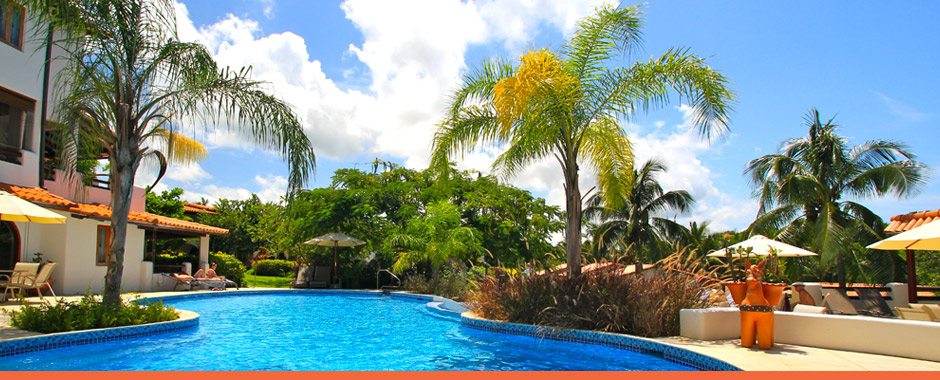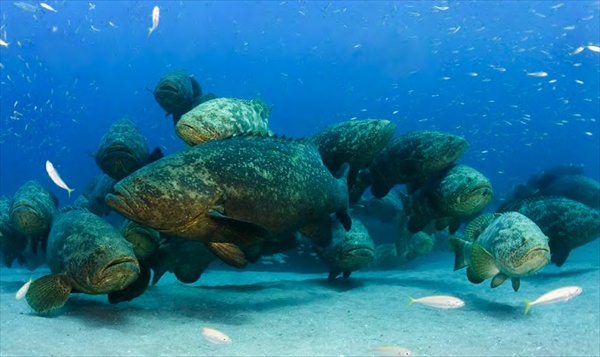![]()
- It's Time To Renew For Discounted Rates
- International Dive Trip - Barbados
- Continuing Education - Rescue Diver
- Goliath Grouper Spawning
- Demystifying the Dive Computer
- Our Florida Reefs Survey
- My First Dive
- Fish Identification Series - Jacks
- Diving Tips and Tricks - Wetsuit Care
- Shore Diving in South Florida - Dania Beach
- New Study Shows South Florida Soft Corals May Withstand Climate Change
- ADA T-Shirts For Sale
- Have you Moved or Changed Email Addresses Lately
- Newsletter Delivery
- ADA Guidelines and Policies
It's Time To Renew For Discounted Rates
The clock is counting down and we are nearing the last chance to renew at a reduced rate. Renew before March 31, 2015 and your membership fee is only $35 for a year of discounts and diving news. After March 31, your annual membership renewal fee is $45.
 Your membership includes periodic
eNews emails about club activities as well as electronic
access to The Mouthpiece monthly newsletter. You may pay
by check or online. Go to http://activedivers.org/Membership-Renewal.html to renew
your membership online. To pay by check, mail a check
made out to "Active Divers Association" with the
appropriate amount to:
Your membership includes periodic
eNews emails about club activities as well as electronic
access to The Mouthpiece monthly newsletter. You may pay
by check or online. Go to http://activedivers.org/Membership-Renewal.html to renew
your membership online. To pay by check, mail a check
made out to "Active Divers Association" with the
appropriate amount to:
Dr. Dan Baeza
Membership Chairman
Active Divers Association
7592 Parkview Way
Coral Springs, FL 33065
Be sure to include your
snail-mail and email addresses.![]()
Barbados - July 19 - 25, 2015
--by Daryl Johnson and Dan Baeza
Once again, Dan and I have tirelessly scoured through countless alternatives to put together a great ADA dive trip for the upcoming season. We actually found this one while at the DEMA (Diving Equipment Manufacturers Association) show in Las Vegas last month. We were able to meet with the dive operator and review his operations as well. This year’s trip to Barbados is from Sunday July 19, 2015 to Saturday July 25, 2015, and includes the following:
6 nights accommodations (double occupancy) at the Sugar Cane Club Hotel and Spa in St. Peters Parish
5 days of two tank diving with one additional afternoon dive with Hightide Watersports (http://www.divehightide.com/about.shtml )
Airport transfers and all taxes
Air temperatures range from a daytime high of 86°F to a nighttime low of 77°F. Rainfall is moderate at 5 inches for the month. Water temperature is a tepid 82°F.
Check out the hotel by following this link to their website (http://www.sugarcaneclub.com/ ) . Pay particular attention to the trip advisor rating. It is #2 in the Caribbean and #15 in the world! This resort has an available all-inclusive food and drink package for those that want to indulge ( at an extra cost of course!). But part of the fun in going new places is discovering new things, and there are 22 restaurants nearby to explore. As usual, the trip does not include airfare, since individuals can purchase airfare cheaper than groups these days.
Ten (10) lucky divers will be going with Dan and I for the bargain price of $989 per person (double occupancy)! To get your spot locked in, click on this link to make a $100 per person deposit By March 1, 2015: http://activedivers.org/Barbados2015.html. Final payment will need to be made by check no later than May 1, 2015.
![]()
Continuing Education - Rescue Diver
The next step under the PADI system after Advanced Open Water is the rating of Rescue Diver. It is the pre-requisite for both Divemaster, the first PADI Professional rating, as well as Master Scuba Diver, the ultimate certification for recreational divers.
The PADI Rescue Diver program prepares divers to help prevent and manage major and minor dive emergencies. Rescue Diver candidates learn a variety of in-water rescue techniques that improve skills and confidence as a diver, and prepare candidates for the next level. Most certified PADI Rescue Divers look back on their rescue training as one of the most challenging, rewarding and demanding programs they’ve taken. The subject is serious but the training is fun.
The knowledge review portion of the course includes the psychology of rescue, recognizing diver stress, emergency preparedness and response, accident management, equipment problems, thermal problems, missing diver procedures, dealing with an unresponsive diver both underwater and at the surface.
The in-water portion of the course includes demonstrating rescue skills (tired diver, panicked diver, unresponsive diver, missing diver etc.), and practicing rescue scenarios such as how to deal with an unresponsive diver underwater and at the surface.
The Rescue Diver course is a great next step for Advanced Open Water divers wishing to further their training, learn valuable skills and have more confidence in the water as a result.
![]()
Every year in mid-September a natural phenomenon occurs in our local ocean waters. The goliath grouper aggregate in groups of 20-50 in a mating ritual that is a wonderful sight to see. Goliath Groupers, once threatened due to overfishing, have been a protected species since 1990 and have since rebounded in abundance. These large fish can grow up to 8 feet in length and weigh up to 800 lbs.
On September 13th of this year, five brave ADA divers set out from Jupiter Diver Center to witness this annual aggregation. Unfortunately, the captain had some trouble figuring where exactly to drop the divers over the MG 111 and Zion Train wrecks.
On the first dive my husband John and I went straight to the bottom as the divemaster and the rest of the group floated away over the sand, seeing nothing. We crawled along against the current until a manmade cement pillar came faintly into view. I went to it with a hunch that the wreck would be nearby. I saw about 8 of the large beasts around the pillar. I continued in the same direction crawling on the bottom until we came upon the wreck where maybe 30-40 groupers were swirling around in the wreck. The fish were completely oblivious to our presence as they were completely wrapped up in their mating ritual.
The second dive took us to the Zion Train wreck where we saw many on this wreck. All in all, this was a day of tough diving between the disoriented captain, the strong current, cold thermalclines and less-than-optimal viz. However, seeing the groupers spawning in such numbers in their natural habitat make the effort well worth it.
About three years ago I went with Jim Abernethy’s out of West Palm on a 3-tank grouper spawning dive with lunch in which the water was warm, clear and the diving effortless. This would be my choice for next time around. Any way you do it, this incredible site is well worth the time and effort to experience.
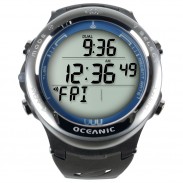 Gone are the days when
divers have to rely on tables to dive safely. In this era
of modern technology, dive computers are an indispensable
must-have on every diver’s gear list. They are convenient,
easy to use and most importantly, they provide information
to help you stay within safe diving limits.
Gone are the days when
divers have to rely on tables to dive safely. In this era
of modern technology, dive computers are an indispensable
must-have on every diver’s gear list. They are convenient,
easy to use and most importantly, they provide information
to help you stay within safe diving limits.
Computers come in all shapes, sizes and prices. They range from $150 for the most basic models to upwards of $2,000 for the fanciest ones. Some are worn on the wrist while others are integrated into the console. Some are air-integrated and act as a pressure gauge, and others have special features such as a built-in compass that functions on land or underwater, and wrist computers with wireless air integration.
But all dive computers, regardless of price, have some
basic features in common. Nearly all are pushbutton or
water activated, with a different mode on land vs.
underwater. The most important information a dive computer
provides during a dive is depth, elapsed dive time, and
no-stop or no-decompression (“safe”) minutes. Most also
give the water temperature, clock time, length of surface
interval and a dive planning mode that shows
no-decompression limits for every given depth down to 130
feet, taking into consideration your theoretical nitrogen
absorption at any given moment. Another very important
feature is dive log mode, which displays stored
information (entry and exit time, depth, etc.) about your
last several dives for easy reference. Lastly, nearly
every computer on the market today offers a separate
setting for Nitrox, which is very important for those who
are Nitrox certified, and those who will be someday.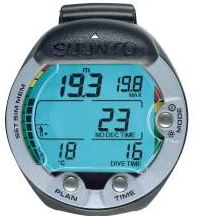
The most important thing you can do is to read your computer’s manual and become fully familiar with all of its functions and settings. It is important to know what the numbers mean underwater, particularly depth, elapsed dive time and remaining no-stop (“safe”) minutes. You should also be able to access the dive planning mode and data from previous dives. Lastly you should be able to easily switch from air to nitrox and set the oxygen percentage in the Nitrox mix on each dive. Don’t expect anyone else such as the dive master on the boat or ADA Safety Officer to show you how to set your computer, since every model is different and there is almost no consistency in the settings between brands and models.
Dive computers offer convenience, safety and allow for maximum bottom time. But it is every diver’s responsibility to be very familiar with your own brand of computer, know how to set it, find the data you’re looking for, and most importantly to understand and heed what it is telling you in order to stay safe on every dive.
![]()
Take the Our Florida Reefs Survey
The Our Florida Reefs survey seeks to collect data on how
and where southeast Florida’s coral reefs are being
enjoyed by residents and guests. This gives an opportunity
for all stakeholders to participate in the Our Florida
Reefs community planning process by letting us know how
you enjoy our reefs.
All survey participants’ data will be combined to create
maps that show a summary of where people are visiting the
reefs, what activities they are participating in, and how
often those areas are visited. This information will allow
the Our Florida Reefs community working groups to be
better informed to recommend management actions that will
help ensure a balance between resource use and protection.
Survey sponsor Amanda R. Costaregni is a Graduate Research
Assistant, GIS and Spatial Ecology Lab at Nova
Southeastern University Oceanographic Center. She will be
the speaker at our March kickoff event informing us about
this project, and other coral reef research and
conservation efforts.
Click here to take the survey.
Return to Index--by Rachel Davis
![]()
I can’t remember much about my first dive, since it was over 30 years ago! But I do remember being with my dive instructor, Yvonne Harper. She was a native Caymanian and dove with Captain Don in the 1960’s. I was in my early 20’s and best friends with Yvonne’s daughter, Diana.
Diana had a new boyfriend and she thought it would be a great idea to have her mother teach me and Alex how to dive. Then we could all go on adventures to the Cayman Islands. On our first open water dive, I remember laughing at Alex because he vomited underwater. He was so embarrassed! And I was so “mean”.
Flash forward 30 years.......
One day, I walked by our swimming pool and saw my 9 year old daughter, Juliana doing the moonwalk on the bottom of an 8 ½ foot pool. She came up slowly and showed me all the rocks she had stuffed into her bathing suit. I asked if her ears hurt. She said “yeah, but its fun.” That’s when I decided Juliana had better learn to scuba dive and learn all the science that goes with it! We hired Sally Siebert (now at Florida Keys Diver) to teach the junior open water. We all went to Bonaire this summer and Juliana really blossomed as a diver. We then hired ADA’s own Rachel Davis to finish the Advanced Open Water !
![]()
Pictures from Florida Fish and Wildlife Conservation Commission and information from Wikipedia
The Elopidae are a family of ray-finned fish containing the single genus Elops. They are commonly known as ladyfish, skipjacks, jack-rashes, or tenpounders. The name comes from the Greek ellops - a kind of serpent.
 The ladyfish are a
coastal-dwelling fish found throughout the tropical and
subtropical regions, occasionally venturing into temperate
waters. Spawning takes place at sea, and the fish larvae
migrate inland entering brackish waters. Their food is
smaller fish and crustaceans (shrimp). Typically
throughout the species, the maximum size is 1 m (3.3 ft)
and the maximum weight 10 kg (22 lb). The body is fusiform
(tapering spindle shape) and oval in cross-section; being
slightly laterally compressed, and the eyes are large and
partially covered with adipose eyelids.
The ladyfish are a
coastal-dwelling fish found throughout the tropical and
subtropical regions, occasionally venturing into temperate
waters. Spawning takes place at sea, and the fish larvae
migrate inland entering brackish waters. Their food is
smaller fish and crustaceans (shrimp). Typically
throughout the species, the maximum size is 1 m (3.3 ft)
and the maximum weight 10 kg (22 lb). The body is fusiform
(tapering spindle shape) and oval in cross-section; being
slightly laterally compressed, and the eyes are large and
partially covered with adipose eyelids.
Like those of eels, the larvae are leptocephalic - being highly compressed, ribbon-like, and transparent. After initial growth, they shrink and then metamorphise into the adult form.
This family is fished, but the body is bony and therefore this fish is not marketed widely for consumption. They are caught and used as bait or may be ground down for fish meal.
It's the end of dive season, although it never really ends in south Florida, and that wetsuit can almost swim on its own. You've diligently soaked it in fresh water after each dive and perhaps even used one of the enzymatic cleaning products available in your local dive shop. Those cleaners work well, yet the suit still has a distinctive, shall we call it aroma, wafting over it. Well, cleaning it thoroughly is as close as your washing machine. Running it through a gentle wash and spin cycle with a small amount of laundry detergent will clean it like new.
Be sure to rinse the salt water out before putting your wetsuit in the washer, as you don't want to introduce the corrosive effects of salt water to your washing machine. Measure a small amount of detergent into the washer and set the controls to "knit" or "delicate". You don't want to agitate the suit too much during the spin cycle. You can safely throw all your wetsuit-related products into the washer, including hoods, vests, booties, and gloves.
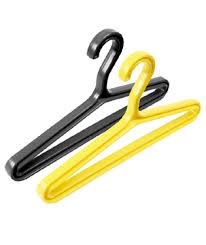 Once the excess water
has been removed during the spin cycle, hang the suit up,
out of direct sunlight, preferably indoors. Do not hang
the suit by the shoulders, as the weight of the suit may
cause the neoprene in the shoulders to separate. Fold it
over the hanger it like you would hang a pair of pants. A
wide plastic wetsuit hanger is ideal. If one is not
available, put two or three plastic hangers together and
drape the suit over them. After one side is dry, turn the
suit inside out and continue the drying process.
Once the excess water
has been removed during the spin cycle, hang the suit up,
out of direct sunlight, preferably indoors. Do not hang
the suit by the shoulders, as the weight of the suit may
cause the neoprene in the shoulders to separate. Fold it
over the hanger it like you would hang a pair of pants. A
wide plastic wetsuit hanger is ideal. If one is not
available, put two or three plastic hangers together and
drape the suit over them. After one side is dry, turn the
suit inside out and continue the drying process.
I have used this technique on my current wetsuit for over ten years. It has been on many hundreds, perhaps thousands of dives, and although the outer shell is a little faded, the suit still does the job it was designed to do.
![]()
This location is at Dania Beach. Park at the farthest north location (near the pier) that you can, then walk north 50 to 100 yards. Enter anywhere along this stretch. Swim out on the surface at least half the pier length. From there, swim directly east until you hit the ledge. It is well defined at this location and there are interesting spots on the way out. Continue your dive south along the ledge until you past the pier by 25 yards or more. Swim at a southwesterly angle and you will find a great nook and crannie spot. You can explore this for quite awhile. When your air dictates, swim towards the shore. The swim to shore is also very interesting as there is much to see. Enjoy.
New Study Shows South Florida Soft Corals May Withstand Climate Change
The oceans absorb more carbon on a planet increasingly choked by greenhouse gases, scientists worry its reefs — the great storm-deflecting rampart for much of the tropics — will crumble and fall.
But for the first time, a new study by the University of Miami Rosenstiel School of Marine and Atmospheric Science and a team of international scientists has found that at least one soft coral, the shrub-like sea rod found throughout South Florida, the Gulf of Mexico and the Bahamas, is more resilient to ocean acidification fueled by carbon than previously thought. Unlike hard corals and other marine animals with shells that need less acidic water to build calcified skins, corals with interior skeletons like the sea rod can survive.
For marine biologists, it’s a bit of good news in a growing catalog of risks as they race to manage oceans 30 percent more acidic than a century ago.
Show your pride in the best dive club anywhere! Sizes small, medium, large, xlarge, xxlarge. Some tank tops available also. All shirts are $10 each. CALL LON AT 305-251-4975 AND PLACE YOUR ORDER TODAY!. Lon will deliver it to you on your next dive

If so, please email or call us with your current information. you may send an email to: Dr. Dan Baeza, Membership Chair at dmbaeza@bellsouth.net. You can also call Dan at 954-260-8225 and leave a message with your new contact information.
![]()
Want your newsletter delivered via snail-mail? Contact Carol Cox at ccox911@att.net and request a printed copy. Be sure to put "ADA Newsletter" in the subject.
